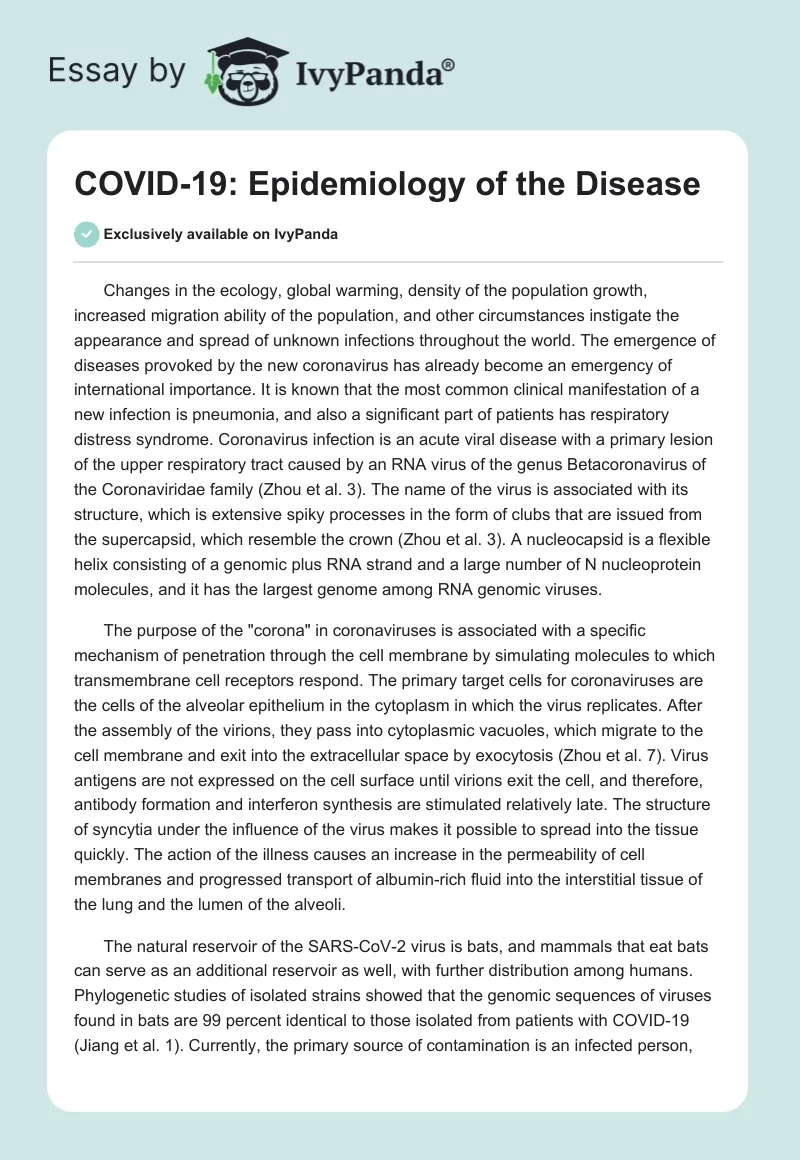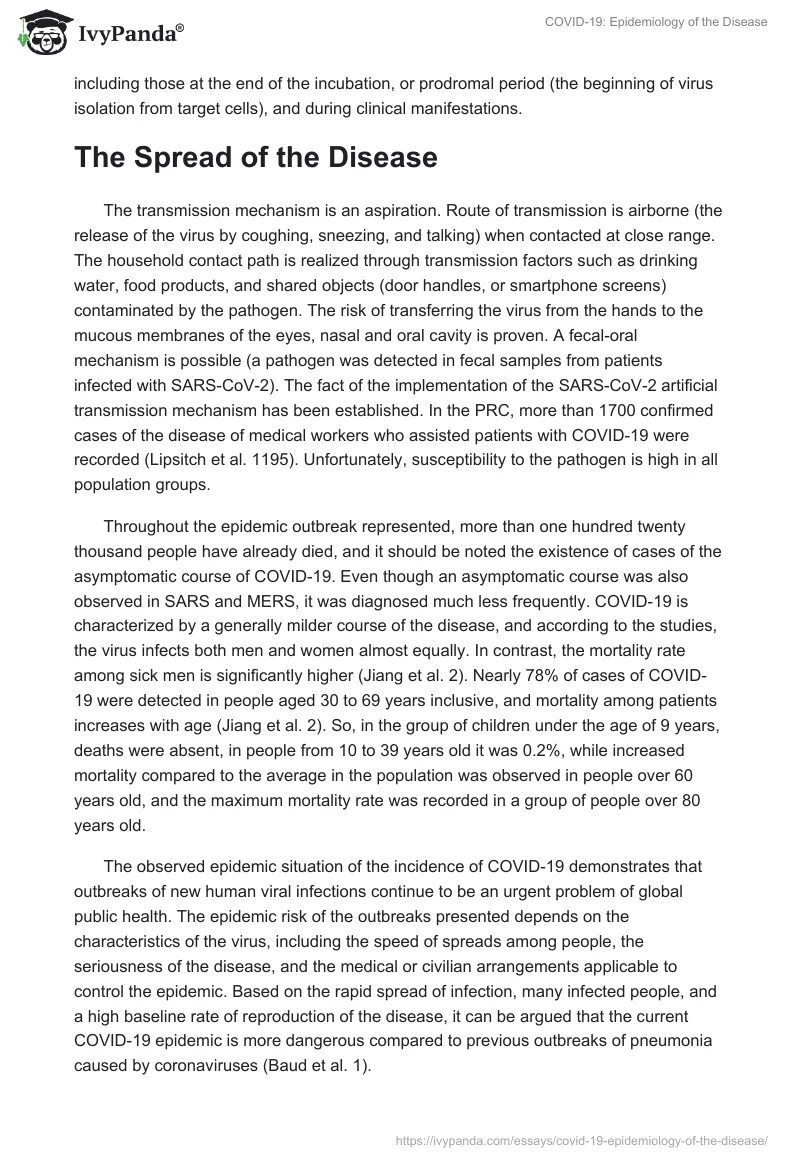Changes in the ecology, global warming, density of the population growth, increased migration ability of the population, and other circumstances instigate the appearance and spread of unknown infections throughout the world. The emergence of diseases provoked by the new coronavirus has already become an emergency of international importance. It is known that the most common clinical manifestation of a new infection is pneumonia, and also a significant part of patients has respiratory distress syndrome. Coronavirus infection is an acute viral disease with a primary lesion of the upper respiratory tract caused by an RNA virus of the genus Betacoronavirus of the Coronaviridae family (Zhou et al. 3). The name of the virus is associated with its structure, which is extensive spiky processes in the form of clubs that are issued from the supercapsid, which resemble the crown (Zhou et al. 3). A nucleocapsid is a flexible helix consisting of a genomic plus RNA strand and a large number of N nucleoprotein molecules, and it has the largest genome among RNA genomic viruses.
The purpose of the “corona” in coronaviruses is associated with a specific mechanism of penetration through the cell membrane by simulating molecules to which transmembrane cell receptors respond. The primary target cells for coronaviruses are the cells of the alveolar epithelium in the cytoplasm in which the virus replicates. After the assembly of the virions, they pass into cytoplasmic vacuoles, which migrate to the cell membrane and exit into the extracellular space by exocytosis (Zhou et al. 7). Virus antigens are not expressed on the cell surface until virions exit the cell, and therefore, antibody formation and interferon synthesis are stimulated relatively late. The structure of syncytia under the influence of the virus makes it possible to spread into the tissue quickly. The action of the illness causes an increase in the permeability of cell membranes and progressed transport of albumin-rich fluid into the interstitial tissue of the lung and the lumen of the alveoli.
The natural reservoir of the SARS-CoV-2 virus is bats, and mammals that eat bats can serve as an additional reservoir as well, with further distribution among humans. Phylogenetic studies of isolated strains showed that the genomic sequences of viruses found in bats are 99 percent identical to those isolated from patients with COVID-19 (Jiang et al. 1). Currently, the primary source of contamination is an infected person, including those at the end of the incubation, or prodromal period (the beginning of virus isolation from target cells), and during clinical manifestations.
The Spread of the Disease
The transmission mechanism is an aspiration. Route of transmission is airborne (the release of the virus by coughing, sneezing, and talking) when contacted at close range. The household contact path is realized through transmission factors such as drinking water, food products, and shared objects (door handles, or smartphone screens) contaminated by the pathogen. The risk of transferring the virus from the hands to the mucous membranes of the eyes, nasal and oral cavity is proven. A fecal-oral mechanism is possible (a pathogen was detected in fecal samples from patients infected with SARS-CoV-2). The fact of the implementation of the SARS-CoV-2 artificial transmission mechanism has been established. In the PRC, more than 1700 confirmed cases of the disease of medical workers who assisted patients with COVID-19 were recorded (Lipsitch et al. 1195). Unfortunately, susceptibility to the pathogen is high in all population groups.
Throughout the epidemic outbreak represented, more than one hundred twenty thousand people have already died, and it should be noted the existence of cases of the asymptomatic course of COVID-19. Even though an asymptomatic course was also observed in SARS and MERS, it was diagnosed much less frequently. COVID-19 is characterized by a generally milder course of the disease, and according to the studies, the virus infects both men and women almost equally. In contrast, the mortality rate among sick men is significantly higher (Jiang et al. 2). Nearly 78% of cases of COVID-19 were detected in people aged 30 to 69 years inclusive, and mortality among patients increases with age (Jiang et al. 2). So, in the group of children under the age of 9 years, deaths were absent, in people from 10 to 39 years old it was 0.2%, while increased mortality compared to the average in the population was observed in people over 60 years old, and the maximum mortality rate was recorded in a group of people over 80 years old.
The observed epidemic situation of the incidence of COVID-19 demonstrates that outbreaks of new human viral infections continue to be an urgent problem of global public health. The epidemic risk of the outbreaks presented depends on the characteristics of the virus, including the speed of spreads among people, the seriousness of the disease, and the medical or civilian arrangements applicable to control the epidemic. Based on the rapid spread of infection, many infected people, and a high baseline rate of reproduction of the disease, it can be argued that the current COVID-19 epidemic is more dangerous compared to previous outbreaks of pneumonia caused by coronaviruses (Baud et al. 1).
Disease Prevention
Nowadays, there is no demonstration of the efficiency of applying any drugs for the treatment of the coronavirus. As part of the provision of medical care, monitoring of the patient’s condition is necessary to identify signs of clinical deterioration, such as rapidly progressive ARF and sepsis, and the appointment of therapy following the patient’s condition. Subjects infected with SARS-CoV-2 should receive supportive symptomatic treatment. Specific prophylaxis (vaccine) against COVID-19 is not currently developed. Nonspecific prevention is an activity intended at preventing the extension of infection and is carried out concerning the source of contamination (a person infected), the transmission mechanism of the disease, and the potentially susceptible contingent (protection of people who are or were in contact with an unhealthy person). Measures regarding the source of epidemic include isolation of patients in detached rooms or chambers of the infectious diseases hospital, care, and treatment, and clinic discharge after a double negative result of the examination for coronavirus SARS-CoV-2 (Lipsitch et al. 1196). Measures aimed at preventing the transmission of the viral pathogen are:
- the observance of personal hygiene rules (washing hands with soap, using disposable wipes when sneezing and coughing, and touching face only with clean wipes or washed hands);
- the use of disposable medical masks that must be replaced every 2 hours;
- use of protective clothing for health workers;
- disinfection measures;
- disposal of medical waste;
- evacuation of patients with special transport.
Vulnerable Populations
Immediate contact with medical institutions for therapeutic assistance in case of symptoms of acute respiratory infection is one of the critical factors in the prevention of complications. The risk groups for severe disease and the risk of death include people over 60 years of age, patients with chronic conditions (diseases of the respiratory system, cardiovascular system, diabetes mellitus, and cancer). Mortality of the disease varies from 2 to 4%; however, the SARS-CoV-2 virus is characterized by low environmental resistance (Baud et al. 1). The infection dies under the influence of ultraviolet radiation, disinfectants, and when the temperature remains higher than 40°C for one hour or up to 56°C for 30 minutes (Rothan and Siddappa 102436). On the surface of objects at 18-25 °C, the virus persists viable from 2 to 48 hours.
Biological warnings associated with epidemics of infectious diseases are global, and the COVID-19 pandemic is not the last threat in the 21st century. As Rothan and Siddappa claim in their article, “Epidemiological changes in COVID-19 infection should be monitored taking into account potential routes of transmission and subclinical infections, in addition to the adaptation, evolution, and virus spread among humans and possible intermediate animals and reservoirs” (102437). All countries should be prepared for coordinated actions to prevent the occurrence and spread of infections, for their timely diagnosis, the advancement of treatment and prevention methods, and, of course, for the development of vaccines.
Moreover, early diagnosis and reporting of possible infections, active, supportive treatment of patients, and timely informing of the population about the epidemic situation and prevention of coronavirus diseases are of particular importance. Of course, there is a high level of threat to the global spread of the new virus because of the lack of specific therapy, prevention, and sanitary quarantine supervision (“Unity Studies: Early Investigation Protocols”). At the same time, the development and clinical studies of preventive and therapeutic drugs against coronaviruses give expectations for serviceable mechanisms for the fight and control of coronavirus infections.
Works Cited
- Baud, David, et al. “Real Estimates of Mortality Following COVID-19 Infection.” The Lancet Infectious Diseases, 2020, p. 1.
- Jiang, Fang, et al. “Review of the Clinical Characteristics of Coronavirus Disease 2019 (COVID-19).” Journal of General Internal Medicine, 2020, pp. 1–6.
- Lipsitch, Marc, et al. “Defining the Epidemiology of Covid-19 — Studies Needed.” New England Journal of Medicine, vol. 382, no. 13, 2020, pp. 1194–1196.
- Rothan, Hussin A., and Siddappa, Nagadenahalli B. “The Epidemiology and Pathogenesis of Coronavirus Disease (COVID-19) Outbreak.” Journal of Autoimmunity, vol. 109, 2020, pp. 102433–102437.
- “Unity Studies: Early Investigation Protocols.” World Health Organization, 2020.
- Zhou, Fei, et al. “Clinical Course and Risk Factors for Mortality of Adult Inpatients with COVID-19 in Wuhan, China: A Retrospective Cohort Study.” The Lancet, vol. 395, no. 10229, 2020, pp. 1054–1062.


